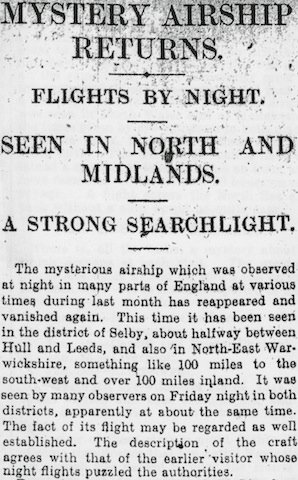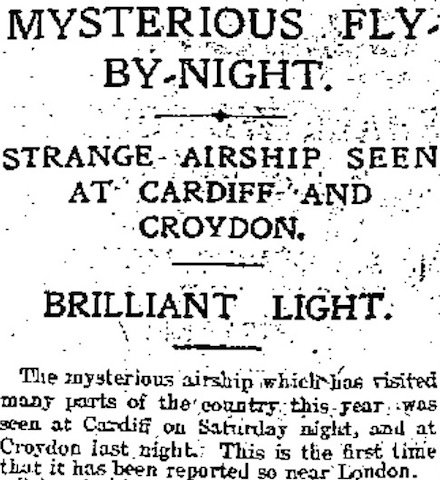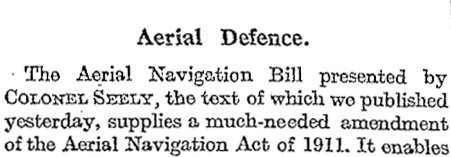
Last week was a relatively quiet one for the phantom airships, but today they receive the most press coverage yet. The main reason for this is a cluster of sightings reported from Yorkshire on Friday, along with another sighting from Warwickshire about 100 miles inland. In fact, there are so many reports that no one newspaper covers them all. According to the London Standard (p. 9; above):
It was seen by many observers on Friday night [21 February 1913] in both districts, apparently at about the same time. The fact of its flight may be regarded as well-established. The description of the craft agrees with that of the earlier visitor whose night flights puzzled the authorities.
The sighting featured most prominently is that of C. H. March, a solicitor and a law lecturer for the Leeds Education Committee, and his wife (though her husband does all the talking, apparently). They were returning to their Selby home after attending a lecture about a mile away. He is quoted in the London Daily Mail (p. 7) as saying:
We left at nine precisely and were in Doncaster-road, Selby, at 9.15. We had just passed the houses in Doncaster-road and had our first clear glimpse of the country to the west when I saw two lights in the sky. It was just about half dark, and though it was impossible to judge accurately I should say the lights were about two miles from us to the west.
“One of the lights was big and bright like the head light of a motor-car. I do not think it was a searchlight, because its ray, which we could plainly see, remained horizontal all the time and did not slant upwards or downwards as though it were movable. The other light was small, and it struck me as possible that it might be a tail light. What makes me think that they were head light and tail light respectively is the fact that at times the big head light would eclipse the smaller tail light, and I think the object to which they were attached was not moving to any great extent but was hovering. The lights were too low in the sky and too big and bright to be stars.”
The Standard adds (p. 9) that it was first seen in the direction of Hambleton, due west:
He drew his wife’s attention to it, and they were astonished to see the light begin to move up and down, and apparently now and then go out. Watching for three-quarters of an hour he observed what he was then certain was a dirigible reconnoitre in different directions for some miles, and then turn at an acute angle, and pass out of view, going towards Leeds.
March ‘believes that it was a foreign aircraft attempting to find out the exact position of a Government magazine in the district’. The Mail doesn’t attribute this belief to him, though it does note that the area is home to ‘Barlby Arsenal, where there is stored a great quantity of army ammunition’ (p. 7). The distinction is worth making because despite the apparent availability of a direct statement by one of the witnesses the various accounts disagree in some particulars. Some are easy enough to explain — the Liverpool Echo, for example, says that he first saw the ‘large dirigible balloon’ when ‘looking out from his house on Brayton-road’ (p. 7); presumably the Marches didn’t stand around on Doncaster Road watching the airship in the cold but continued on their way home and resumed watching it from there. Others are more troubling. Despite March’s clear and reasoned statement, as quoted in the Mail, that the airship did not have a searchlight, the Standard says that ‘He states that an airship with a powerful searchlight hovered over the town’ (p. 9). It could be that there are other accounts available; the Mail‘s quotation is evidently truncated and perhaps in the full statement March says he saw a searchlight switch later. (The other press references to the Marches’ sighting, in the Daily Mirror and the Daily Express, are too brief to help.) Or it could be that the Standard is, possibly inadvertently, making March’s airship conform to other accounts.
There were other airship reports from Selby that same night, though few details are available. The Standard says that Sanderson Daw saw an airship with ‘a powerful head light and rear lights’ passing ‘over Hide-street’ (p. 9). He is presumably the ‘man named Sanderson’ who, according to the Express‘s version, ‘saw the airship over Wide-street [sic], Selby, between 8 and 9 p.m.’ and ‘could distinctly hear the whirr of its engines’ (p. 7). (Quite possibly ‘Sanderson Daw’ is a mistake for ‘Sanderson saw’.) The Express also notes that ‘Two Selby ladies saw it over Selby Common between 9 and 10 p.m., and it was then throwing its searchlights on the hedgerows on the common’ — the Liverpool Echo calls them ‘young ladies who were out walking’ (p. 7).
The same airship, presumably, was seen at 10pm the same night at Church Fenton station, seven miles northwest of Selby. Insurance superintendent John Collinwood (in most accounts; Collingwood, according to the Mirror), was on the platform ‘with a party of Selby business men’ (presumably waiting for a train), reports the Mail (p. 7),
when they observed ‘an airship with a strong searchlight playing on the railway lines.’ It was first very high, then it came down so low that it seemed that it would strike the roofs of the houses. After about twenty minutes in the neighbourhood it left at a high speed, and they then observed a red and green light on either side.
The Liverpool Echo judges this ‘The best account […] probably’ and adds several details: that there were ‘about a dozen’ businessmen with Collinwood, who is also from Selby; that they first heard ‘the whirr of machinery’; that ‘it veered off in a northerly direction’; and that the red and green lights were ‘on the port and starboard side respectively’ (p. 7; this last detail is confirmed by the Standard.)
Another widely-reported sighting was made by J. Creasor at Riccall, about 3 miles north of Selby. Creasor is described by the Daily Mirror as ‘a fruit and potato dealer in Harrogate’ who ‘observed an airship over Riccall at about 7.45, which was showing a large searchlight’ (p. 7). The Mail adds that he also ‘heard the whirr of machinery’ (p. 7). Other accounts of Creasor’s sighting, in the Standard, the Express and the Liverpool Echo, don’t add any further details.
The final airship sighting from Yorkshire on Friday is perhaps the most intriguing. From the Mail:
Mr. Beckerdyke, a commercial traveller, states that between ten and eleven on Friday night [21 February 1913], while driving near Ellerton, his horse was startled by a very bright light ‘from an airship or something of the kind’ which went over the road in front of him. It was going at a rapid rate in the direction of Bridlington.
The account in the Standard is essentially the same. While there is only Beckerdyke’s word for his horse’s reaction, this suggests that there really was, at the very least, a startlingly bright light overhead, whether it was an airship as he thought or no. Ellerton is seven miles northeast of Selby, so that makes six independent but fairly consistent airship sightings by about 20 people (and one horse) from a small region about twelve miles by five in size at the same time on the same night. It’s no wonder the London press has taken notice.
Nor is that all. A number of newspapers also report on an airship seen almost simultaneously in Warwickshire, some 100 miles to the southwest of Selby. From the Standard (p. 9):
Considerable excitement was caused in several parts of North-West Warwickshire, particularly Exhall and Longford, about ten o’clock on Friday night [21 February 1913] by the passage of an airship. It was a very light night, and policemen and colliers on their way home from work sighted the strange craft, which came from the direction of Leicester and went towards Birmingham. It was carrying two headlights and one in the rear.
The Times (which doesn’t mention the Selby sightings at all) says that there were ‘a number of independent reports’ and that the witnesses ‘are positive that they saw the vessel’ (p. 6). Other versions, with progressively fewer details, appear in the Mirror, the Express, and the Globe.
Only the Standard attempts any sort of analysis of all these airship reports, though it doesn’t really make much sense (p. 9):
The times at which the airship reported at Selby was seen and the hour at which the one in Warwickshire was observed seem to point to the flight of two dirigibles, but the discrepancy in the times, if it was after all the same craft, is not necessarily proof to the contrary. It may be remembered that on a previous occasion, when a similar airship was seen in North Wales and at Manchester [sic; presumably South Wales and Liverpool], the times given by eye-witnesses in both places was the same.
It adds that ‘German Zeppelins have attained a speed of at least 43 miles an hour, and have remained in the air over 30 hours on one voyage’, so ‘A flight across the North Sea and back without a stop would be quite easy’. Admittedly, ‘There is, all the same, a mystery about it which deepens at each visit’. After giving a curiously incomplete listing of previous airship sightings, stopping with the Aberystwyth incident on 25 January, the Standard notes that ‘in every case observers report a bright light or lights’, and in the case of Aberystwyth, that ‘the vessel carried and used searchlights’.

The Globe was evidently not aware of the Selby sightings at the time it went to press, but it tries to link the Warwickshire airship with a test flight by ‘L.Z.I.’ (i.e. Ersatz Z I), the new military Zeppelin (p. 12):
It will be seen, however, that whereas the Warwickshire visitant was seen on Friday night, the Zeppelin is recorded as having made its 13 hours’ flight on its secret journey on Saturday night. This conflict of dates has been observed before, since the presumed nocturnal dirigible first began to attract attention, although in the minds of most people entitled to judge, there is no doubt that on at least two occasions of visits of unknown airships the aircraft concerned actually hailed from Germany.
This is a reference to the Dover incident at the start of the year and the Sheerness incident of last October, both of which have supposedly been confirmed by government sources as caused by German airship flights. The Globe carries extracts from a lengthy article from today’s Manchester Courier, arguing the German theory for Sheerness. The Courier‘s ‘special correspondent’, whose conclusions are backed up in a leading article (p. 6), is unfortunately not named, but was evidently in Germany last month and saw a (non-mysterious) Zeppelin flight from Johannistal. It is (perhaps fortunately) too long to summarise in any detail, but despite the quality of the writing and familiarity with aviation it doesn’t actually add much that’s new: it lays out the immense German superiority in airships compared with Britain (35 after mobilisation), their probable use in wartime (at the outbreak of hostilities, to ‘partially demobilise the British Fleet by depriving it of its coaling and repairing bases’), the difficulty of air defence (hitting airships with guns is almost impossible; ‘a comprehensive system of aeroplane patrols around the coast’ would be expensive but probably the only real means of defence), the need for Britain to acquire its own like fleet of large airships ‘so that in case of an attack […] we should be in a position to return the compliment without delay’ (p. 7). Certainly, with regards to the mystery airships, the author thinks that ‘in view of subsequent proof that no British airships were abroad on the nights in question, it is clear enough that these nocturnal visitations are made by foreign craft, and only Germany and France own dirigibles capable of making extended flights’; and obviously they can’t be French, ‘for the excursions are not such as would be undertaken by aerocraft belonging to a Power on particularly friendly terms with Great Britain’. However, no actual evidence is presented here that the Courier‘s candidate, ‘M.L. 1’ (i.e. L1 AKA LZ14), actually did fly over Sheerness instead of following the course claimed by the German government, other than (1) it was within the airship’s capabilities and (2)
Whatever the truth of the matter may be, it is worth noting that no member of the crew of the airship would either deny or affirm that the digression had been made.
There is also the small matter of the Sheerness incident not taking place on the night of 13 October 1912, as claimed by the Courier‘s correspondent, but a whole twenty-four hours later on the night of 14 October, by which time L1 had already landed at Johannistal. The Globe is clearly aware of this discrepancy; the Courier either is not or chooses not to mention it. Still, the map is nice.
Finally, the Standard, as is now almost obligatory, mentions that ‘In view of these strange night flights, it is of some significance that the Aerial Navigation Act, which was passed through the House of Commons and the House of Lords in an almost unprecedentedly short time, and received the Royal Assent on the adjournment of Parliament’ provides for the prohibition of flying over certain areas and the shooting down of ‘unknown aircraft’ if orders to land are not obeyed (p. 9). The Globe‘s military correspondent says something similar: ‘In view of the recent visits of strange aircraft to the neighbourhood of some of our important fortifications, it is interesting to notice that a Bill has been introduced […]’ (p. 8). They add that the Bill (or rather Act, as it now is — apparently they don’t talk to the parliamentary correspondent) ‘will enable us to frustrate any attempt to ravage the country by means of airships before the formal outbreak of war’.
![]() This work is licensed under a Creative Commons Attribution-NonCommercial-NoDerivatives 4.0 International License.
Permissions beyond the scope of this license may be available at http://airminded.org/copyright/.
This work is licensed under a Creative Commons Attribution-NonCommercial-NoDerivatives 4.0 International License.
Permissions beyond the scope of this license may be available at http://airminded.org/copyright/.






Pingback: Tuesday, 25 February 1913
Pingback: Wednesday, 26 February 1913
Pingback: Thursday, 27 February 1913
Pingback: Friday, 28 February 1913
Pingback: Sunday, 2 March 1913
Pingback: Thursday, 6 March 1913
Pingback: Sunday, 16 March 1913
Pingback: Friday, 4 April 1913
Pingback: Thursday, 17 April 1913